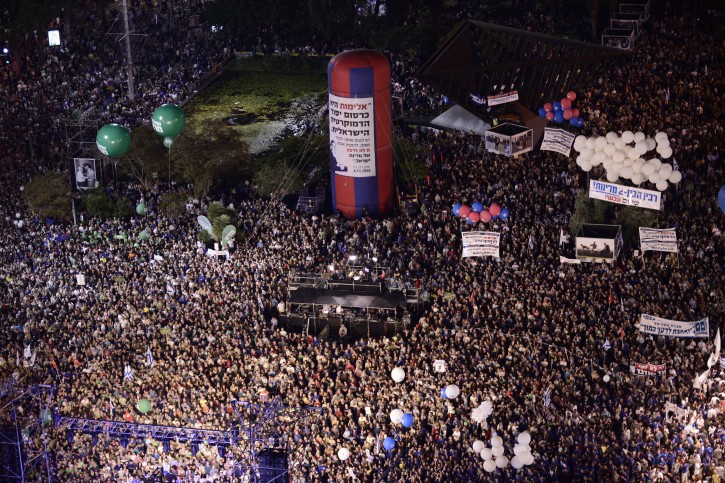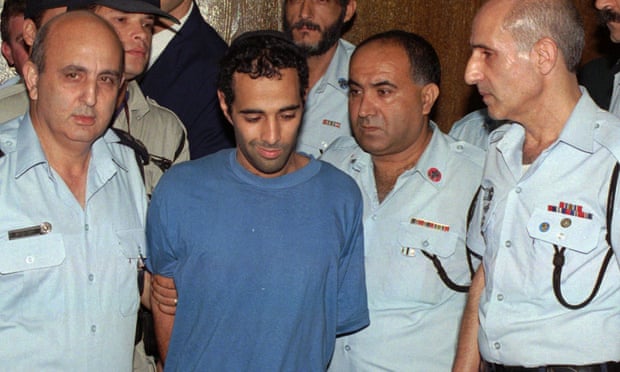In the peace-killers' twisted world

Thousands attend a rally marking 20 years since the assassination of the late Israeli Prime Minister Yitzhak Rabin at Tel Aviv’s Rabin Square on October 30, 2015, Yitzhak Rabin was assassinated on November 4, 1995 by an Israeli extremist during a pro-peace rally in Tel Aviv. Photo by Tomer Neuberg/Flash90
Twenty years ago, Yigal Amir, a 25-year-old Jewish extremist, assassinated the Israeli prime minister, Yitzhak Rabin. In this excerpt from his book Killing a King: The Assassination of Yitzhak Rabin and the Remaking of Israel, Dan Ephron describes the moments that followed
The Observer
November 01, 2015
Within seconds of the shooting, policemen had cuffed Amir on the ground, then lifted him to his feet and ran with him to the outer wall of a small shopping mall that bordered the parking lot. At least 15 men pressed up against him, clutching his arms and patting him down but Amir heard the voice of just one policeman asking questions in rapid succession: Were the bullets real? Was the prime minister the intended target? Amir had regarded his lunge at Rabin as an act of suicide, yet somehow he was alive. He responded loudly enough to be heard over the chaos: Yes, he intended to shoot Rabin and yes, the bullets were real. Inspector Yuval Gershon pushed him into a police car, a late-model Subaru, and got in behind him.
Already on the ride to the station, Amir delivered a full confession. He was a law student at Bar-Ilan University, he owned the Beretta that police had picked up in the parking lot, he had gone to the square intending to shoot the prime minister, and he was reasonably sure his bullets had struck Rabin. For the policemen in the car – Gershon and three others – the incident itself had been a bewildering experience. Amir’s swagger, his nonchalance, added another layer of astonishment.
One of the men asked Amir if he’d been aware that his actions could cause Rabin’s death, information that in court would help establish intent. Amir, who had completed two full years of law school, including at least two courses in criminal law, understood the question. Not only was I aware, he said. That was my objective.
The bluster continued pouring out at the precinct, along with a giddiness that made Amir seem weirdly detached from the enormity of his crime. Before he was even booked, he asked first sergeant Yohanan Ronen to reach into the pocket of his jeans, pull out his skullcap, and put it on his head. The policeman obliged. While pressing his fingers to an inkpad, Amir noticed that his wrist was bare. “My watch fell off in the parking lot,” he remarked to the lab technician. “Can you check if someone found it?” To the technician, it must have seemed like the suspect had mistaken him for a summer-camp counsellor. “We’ll let you know,” he said.
Throughout the booking, Amir kept replaying the shooting in his mind. Though it remained unclear to him whether Rabin had survived, Amir was now certain that God had wanted him to act, that he’d managed to fathom God’s will, in the words of that settler rabbi. The proof was in the outcome. Only divine intervention could account for the fact that he eluded police for 40 minutes, outmanoeuvred Rabin’s vaunted protection force, and fired at the prime minister without getting shot himself.

A smirking Yigal Amir, second from left, is led into a Tel Aviv courtroom. Photo by Nati Harnik/AP
In one of the waiting rooms, he told a policeman his act would cause people to rise up. “I don’t want people to think I’m crazy. Otherwise, I won’t achieve my goal.” To Ronen, he explained that the Talmudic doctrine din rodef amounted to a death sentence for Rabin – an explication that only people familiar with the internal discourse in the Orthodox community over the preceding year would have understood. When the policeman pointed out that even the most hardline political parties would condemn the assassination attempt, Amir seemed untroubled. “I didn’t do it in order to go down in history,” he said. Then he added: “But you guys will be famous.”
In the interrogation room, Amir faced Motti Naftali, the chief superintendent who had helped draft the security plan for the rally. Word had reached the precinct by now that Rabin had died on the operating table. With a pipe wedged in the corner of his mouth, Naftali told Amir he would be charged with the murder of prime minister Yitzhak Rabin. Amir’s response nearly unhinged the police officer. Amir threw up his cuffed hands and declared, “I did it.” Then he asked Naftali if he could bring a drink – a “schnapps”, he said – to toast the news.
While the interrogation continued, several policemen and investigators of the security agency Shabak made their way to Borochov 56 in Herzliya, to search the house and pick up Hagai. Forensic technicians had already discovered the modified bullets at the bottom of Amir’s magazine. When Naftali asked about them, Amir said they were the handiwork of his brother, Hagai, and bragged about his technical skills. Now Hagai was a suspect as well.
In Herzliya, Hagai waited for a knock on the door. He’d been watching a television movie earlier in the evening when a newscaster interrupted the programme to report that shots were fired in Rabin’s vicinity at Kings of Israel Square. Though the initial details were scant, Hagai knew immediately that it was his brother. He turned to his father and told him to brace himself – Amir had tried to kill Rabin at the peace rally. Shlomo erupted: What did you and your brother do? How could you do this to me?

1995: More than 100,000 Israelis crowd Tel Aviv’s municipal square in a show of support for the government’s peace-making policies. Photo by AP
An hour passed and somehow the police had still failed to show up. Hagai considered dismantling some of his homemade armaments, including the grenades and the timers. The parts alone would be less incriminating. But he worried that investigators would walk in as soon as he got to work. Instead, he grabbed what he could from the bedroom and the shed and stashed it in a small chicken coop he’d built over the summer in the backyard – on the left side, near the incubator. The deadlier munitions, the TNT sticks and C-4 explosives, remained hidden in the attic and inside one of the walls.
Back in the house, he spotted a relative who lived in the neighbourhood and had come over to console the family. Hagai still had a few things left to hide, a supermarket bag with fuses, explosives, and the handcrafted silencer. He pulled the relative, Uriel Ben-Yaakov, to the back patio and asked if he’d be willing to stash the munitions in his home. In the dimly lit yard, Hagai opened the bag and showed him the contents. When Ben-Yaakov refused, Hagai pointed to the hiding place in the coop and asked him to remove the materials after he was arrested.
The policemen and Shabak agents, delayed apparently by the chaos, finally pulled up around midnight. On the street, journalists were knocking on doors to interview people about their neighbour, the assassin. Inside, the friends still lingered; Shlomo sat alone in a bedroom reading Lamentations.
The officers took Hagai to a bathroom, told him to undress, and searched him. Then they combed the shed and the bedroom he shared with Amir, confiscating whatever items seemed relevant. In several boxes, they carted off the ammunition Hagai left lying around and tools from his shed but also a phone book, four photo albums, a camera with film in it, and a worn copy of The Day of the Jackal. Near Amir’s bed, they found a book titled Baruch the Man, a paean to Baruch Goldstein who had massacred 29 Palestinians as they worshipped in a mosque in Hebron. Amir had not only devoured the 533-page book, he’d recommended it to friends.
The officers walked Hagai out and cuffed him in the car. Borochov, the sleepy suburban street, swarmed with people. At one in the morning, the day was not over yet.
In Tel Aviv, Shimon Peres had gathered Rabin’s cabinet ministers to formalise the transition of power. Alongside his responsibilities as foreign minister, Peres held the title of deputy prime minister, which meant he would be leading the government through the transition period.
Dressed in the same suit and tie he’d worn on stage a few hours earlier, his face pale and heavy, Peres looked wretched. He struggled to deliver a brief eulogy for Rabin and kept his gaze down through much of the meeting. Peres had preceded Rabin in the parking lot by a few minutes. In updates he received from the interrogation room, he learned that Amir had considered shooting at him but decided to wait for the prime minister.
Had the two men come down together, Amir told Naftali, he would have killed them both. The trifecta – losing Rabin, having the country’s leadership thrust suddenly upon him, and realising he’d barely escaped death himself – had induced in Peres a kind of post-traumatic stress.

Rabin addresses a mass peace rally of more than 100,000 Israelis at Tel Aviv’s municipal square before he was assassinated, November 4th, 1995. Photo by Nati Harnik/AP
Rabin had now been dead for three hours. His body remained in a room at Ichilov hospital, waiting for the autopsy. Doctors had left the clothes he’d been wearing in a neat pile, a pack of Parliaments still stuffed in his jacket pocket. At two in the morning, the government’s chief pathologist, Yehuda Hiss, walked in with an assistant and began to probe what precisely killed Rabin. Speaking into a tape recorder, Hiss described what he saw: “The body of a man who looks to be about 70, nutritional condition looks normal, measuring 172 centimetres from his left heel to the top of his head, naked and covered in sheets.”
He noted the obvious and the obscure: the long lines of stitches crisscrossing Rabin’s chest and abdomen where surgeons had cut him open and the yellow stains between his index and middle fingers from a lifelong smoking habit. In back, Hiss traced the pathway of the bullets into Rabin’s body. One hollow point entered his lower back, ruptured his spleen, then travelled up and to the right, where it punctured his left lung. The other pierced his back below the clavicle, smashed through the rib cage, and entered the right lung.
The massive bleeding alone and the collapse of his lungs had made Rabin’s chances of surviving the shooting extremely low, Hiss concluded. But it wasn’t until doctors wheeled the body to a lab room for a brain scan that the full picture came into view. In the computerised image, they noticed an embolism in one of Rabin’s cerebral arteries, a large pocket of air that entered his bloodstream in the lungs and made its way to his brain, restricting the flow of blood and oxygen. The blockage, it was now clear, had hindered the resuscitation effort and, with every passing moment, eroded the prime minister’s mental capacity.
In effect, Rabin’s brain died well before his body did.
*****

Published by WW Norton and Co., October 2015
From the publisher’s blurb:
“Ephron reconstructs the relentless scheming of Amir, a twenty-five-year-old law student and Jewish extremist who believed that Rabin’s peace effort amounted to a betrayal of Israel and the Jewish people. As Amir stalked Rabin over many months, the agency charged with safeguarding the Israeli leader missed key clues, overlooked intelligence reports, and then failed to protect him at the critical moment. It was the biggest security blunder in the agency’s history…. One can’t help but wonder what Israel would look like today had Rabin lived.
